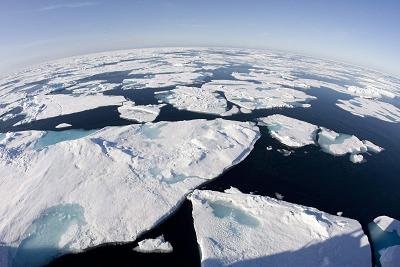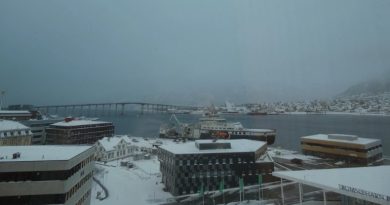New fiber optic cables means competition moves to Arctic seafloor
 First it was server cooling rooms. Now, new, trans-Arctic telecommunications cables might be the next big thing up North.
First it was server cooling rooms. Now, new, trans-Arctic telecommunications cables might be the next big thing up North.
At this year’s Pacific Telecommunications Council conference in Honolulu, Hawaii, there was much talk about a potential subsea optical transmission cable that could be laid under the Arctic Ocean thanks to the melting ice cap. Network World reports that with this cable, internet, voice, and private traffic could go directly between Asia and Europe, doing away with the need to pass through North America.
The Toronto Star and Nunatsiaq News have more details on the proposed 15,600 kilometer Canadian cable, which would run between London and Tokyo via the Northwest Passage. Northern China and Japan and Northern Europe would then have a lower latency connection between them, which could be beneficial for financial centers in both continents.
Education, telemedicine would get boost
Fast internet is one of the keys to spurring growth in the Canadian North. Given the remote distances, telemedicine and online schooling are more popular and practical solutions than in other places. With faster internet speeds, such industries could take off even more. Arctic Fibre’s proposed cable would reach the settlements of Cambridge Bay, Gjoa Haven, Taloyoak, Igloolik, Hall Beach, Cape Dorset and Iqaluit. Many are skeptical, though, that such an investment would be profitable. Given the huge price tag and the small amount of people in the High North, it’s likely that the project would have to be heavily subsidized by the government.
Cunningham envisions that Canada would finance one third of the CAN $640 million project, while Asian, American and European telcoms would pay for the other two thirds. In Canada, he’s hoping to win support from the territorial government of Nunavut and the Canadian High Arctic Research Station, where he claims broadband internet could be a real boon. Cunningham remarked on the station, “If you’re sending them there, they need broadband to do their jobs properly. It’s something we take for granted here.” Of course, the scientists in Antarctica do not have broadband internet, nor do scientists working on icebreakers at sea. They all use satellite internet, so service provided at this level is presumably functional enough to let researchers do their jobs.
Competition expected
Arctic Fibre will have to compete against a possible fiber optic cable through the Arctic passage to the east: the Northern Sea Route. Polarnet Project (in Russian) intends to lie down a fiber optics cable from London to Murmansk, Anadyr, Beijing, and Tokyo. Other parts of China, northern Russia, and Seoul would also be connected by this cable. The Russian Optical Trans Arctic Submarine Cable System (ROTACS) is already further along than the Canadian cable. In October 2011, the Russian Governmental Commission for Federal Communications and Information Technology approved the project, and last week, Polarnet Project announced a tender for supply of the cable. The company hopes to begin construction in the second half of this year, while Arctic Fibre wouldn’t get started until at least the third quarter of 2013. Polarnet Project’s website claims that ROTACS would only be 14,700 kilometers, though the Toronto Star reports that it would be a significantly longer 17,000 kilometers; I am not sure of the reason for the difference in measurement.
This is not the first time companies have sought to connect London and Tokyo via the Arctic. In January 2010, it was reported that Khanjee Holding, an infrastructure investment firm, and the Kodiak-Kenai Cable Company wanted to build a similar cable, whose main benefits would have served Alaska rather than Canada. The cable would have had its primary landing in Prudhoe Bay and connections to Dutch Harbor, Nome, Kotzebue, and Barrow. The companies were not successful in obtaining the $350 million in loans they sought from the U.S. government for the project, which ultimately was given a $1 billion price tag.
Now, though, Alaska is out of the picture. It seems that the competition is once again between the Northern Sea Route and the Northwest Passage, though the action is taking place on the seafloor rather than at sea level.




